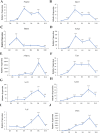Integrated lipidomics and RNA sequencing analysis reveal novel changes during 3T3-L1 cell adipogenesis
- PMID: 35529487
- PMCID: PMC9074861
- DOI: 10.7717/peerj.13417
Integrated lipidomics and RNA sequencing analysis reveal novel changes during 3T3-L1 cell adipogenesis
Abstract
After adipogenic differentiation, key regulators of adipogenesis are stimulated and cells begin to accumulate lipids. To identify specific changes in lipid composition and gene expression patterns during 3T3-L1 cell adipogenesis, we carried out lipidomics and RNA sequencing analysis of undifferentiated and differentiated 3T3-L1 cells. The analysis revealed significant changes in lipid content and gene expression patterns during adipogenesis. Slc2a4 was up-regulated, which may enhance glucose transport; Gpat3, Agpat2, Lipin1 and Dgat were also up-regulated, potentially to enrich intracellular triacylglycerol (TG). Increased expression levels of Pnpla2, Lipe, Acsl1 and Lpl likely increase intracellular free fatty acids, which can then be used for subsequent synthesis of other lipids, such as sphingomyelin (SM) and ceramide (Cer). Enriched intracellular diacylglycerol (DG) can also provide more raw materials for the synthesis of phosphatidylinositol (PI), phosphatidylcholine (PC), phosphatidylethanolamine (PE), ether-PE, and ether-PC, whereas high expression of Pla3 may enhance the formation of lysophophatidylcholine (LPC) and lysophosphatidylethanolamine (LPE). Therefore, in the process of adipogenesis of 3T3-L1 cells, a series of genes are activated, resulting in large changes in the contents of various lipid metabolites in the cells, especially TG, DG, SM, Cer, PI, PC, PE, etherPE, etherPC, LPC and LPE. These findings provide a theoretical basis for our understanding the pathophysiology of obesity.
Keywords: 3T3-L1; Adipogenesis; Ceramide; Diacylglycerol; Lipidomics; Phospholipid; Sphingomyelin; Triacylglycerol.
©2022 Pei et al.
Conflict of interest statement
The authors declare there are no competing interests.
Figures











Similar articles
-
Lipidomic Assessment of the Inhibitory Effect of Standardized Water Extract of Hydrangea serrata (Thunb.) Ser. Leaves during Adipogenesis.Nutrients. 2024 May 16;16(10):1508. doi: 10.3390/nu16101508. Nutrients. 2024. PMID: 38794745 Free PMC article.
-
Single-nucleus RNA sequencing and lipidomics reveal characteristics of transcriptional and lipid composition in porcine longissimus dorsi muscle.BMC Genomics. 2024 Jun 20;25(1):622. doi: 10.1186/s12864-024-10488-8. BMC Genomics. 2024. PMID: 38902599 Free PMC article.
-
Adaptations of the 3T3-L1 adipocyte lipidome to defective ether lipid catabolism upon Agmo knockdown.J Lipid Res. 2022 Jun;63(6):100222. doi: 10.1016/j.jlr.2022.100222. Epub 2022 May 7. J Lipid Res. 2022. PMID: 35537527 Free PMC article.
-
Restoration of the adipogenic gene expression by naringenin and naringin in 3T3-L1 adipocytes.J Vet Sci. 2021 Jul;22(4):e55. doi: 10.4142/jvs.2021.22.e55. J Vet Sci. 2021. PMID: 34313040 Free PMC article.
-
Dietary lysophosphatidylcholine regulates diacylglycerol, cardiolipin and free fatty acid contents in the fillet of turbot.Food Chem X. 2022 Mar 24;14:100293. doi: 10.1016/j.fochx.2022.100293. eCollection 2022 Jun 30. Food Chem X. 2022. PMID: 35356697 Free PMC article.
Cited by
-
Lipidomic Assessment of the Inhibitory Effect of Standardized Water Extract of Hydrangea serrata (Thunb.) Ser. Leaves during Adipogenesis.Nutrients. 2024 May 16;16(10):1508. doi: 10.3390/nu16101508. Nutrients. 2024. PMID: 38794745 Free PMC article.
-
Identification and validation of key genes associated with pathogenesis and prognosis of gastric cancer.PeerJ. 2023 Oct 16;11:e16243. doi: 10.7717/peerj.16243. eCollection 2023. PeerJ. 2023. PMID: 37868053 Free PMC article.
-
Inhibition of triglyceride metabolism-associated enhancers alters lipid deposition during adipocyte differentiation.FASEB J. 2025 Jan 31;39(2):e70347. doi: 10.1096/fj.202401137R. FASEB J. 2025. PMID: 39873971 Free PMC article.
-
A machine learning model for the proteome-wide prediction of lipid-interacting proteins.bioRxiv [Preprint]. 2025 May 25:2024.01.26.577452. doi: 10.1101/2024.01.26.577452. bioRxiv. 2025. Update in: J Chem Inf Model. 2025 Sep 4. doi: 10.1021/acs.jcim.5c01076. PMID: 38352308 Free PMC article. Updated. Preprint.
References
-
- Al Adhami H, Evano B, Le Digarcher A, Gueydan C, Dubois E, Parrinello H, Dantec C, Bouschet T, Varrault A, Journot L. A systems-level approach to parental genomic imprinting: the imprinted gene network includes extracellular matrix genes and regulates cell cycle exit and differentiation. Genome Research. 2015;25:353–367. doi: 10.1101/gr.175919.114. - DOI - PMC - PubMed
-
- Bremer J, Figard PH, Greenberg DM. The biosynthesis of choline and its relation to phospholipid metabolism. Biochimica et Biophysica Acta. 1960;43:477–488. doi: 10.1016/0006-3002(60)90470-4. - DOI
-
- Cao J, Li JL, Li D, Tobin JF, Gimeno RE. Molecular identification of microsomal acyl-CoA:glycerol-3-phosphate acyltransferase, a key enzyme in de novo triacylglycerol synthesis. Proceedings of the National Academy of Sciences of the United States of America. 2006;103:19695–19700. doi: 10.1073/pnas.0609140103. - DOI - PMC - PubMed
Publication types
MeSH terms
Substances
LinkOut - more resources
Full Text Sources
Research Materials
Miscellaneous

